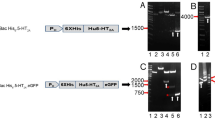Abstract
The human protein Lynx2 belongs to the Ly6/uPAR family of “three-finger” proteins and is associated with the cell membrane by the glycosylphosphatidylinositol (GPI) anchor. Lynx2 is expressed in the brain areas responsible for anxiety level control: prefrontal cortex, basolateral tonsil, hippocampus, and medial dorsal nucleus of the thalamus; it probably participates in anxiety regulation by interaction with α4β2 nicotinic acetylcholine receptor. Currently, the nature of the Lynx2 interaction with the receptor is unknown. We developed a bacterial expression system for production of a Lynx2 water-soluble domain (ws-Lynx2). The protein was obtained in the form of E. coli cytoplasmic inclusion bodies, with subsequent solubilization under denaturing conditions and renaturation. Production of milligram quantities of the 13С-15N-labeled variant of ws-Lynx2 made it possible to characterize the secondary structure of this protein by means of heteronuclear NMR spectroscopy. It was shown that ws-Lynx2 has structure typical for three-finger proteins from the Ly6/uPAR family with some unique features, such as helical elements in the first and third loops. Development of the effective recombinant production system opens up new horizons for further structural and functional studies of Lynx2.




Similar content being viewed by others
REFERENCES
Loughner, C.L., Bruford, E.A., McAndrews, M.S., Delp, E.E., Swamynathan, S., and Swamynathan, S.K., Hum. Genomics, 2016, p. 10. https://doi.org/10.1186/s40246-016-0074-2
Vasilyeva, N.A., Loktyushov, E.V., Bychkov, M.L., Shenkarev, Z.O., and Lyukmanova, E.N., Biochemistry (Moscow), 2017, vol. 82, pp. 1702–1715. https://doi.org/10.1134/S0006297917130090
Miwa, J.M., Iban̆ez-Tallon, I., Crabtree, G.W., Sanchez, R., Šali, A., Role, L.W., and Heintz, N., Neuron, 1999, vol. 23, pp. 105–114. https://doi.org/10.1016/S0896-6273(00)80757-6
Adermann, K., Wattler, F., Wattler, S., Heine, G., Meyer, M., Forssmann, W.-G., and Nehls, M., Protein Sci., 2008, vol. 8, pp. 810–819. https://doi.org/10.1110/ps.8.4.810
Tsuji, H., Okamoto, K., Matsuzaka, Y., Iizuka, H., Tamiya, G., and Inoko, H., Genomics, 2003, vol. 81, pp. 26–33. https://doi.org/10.1016/S0888-7543(02)00025-3
Maher, M.P., Matta, J.A., Gu, S., Seierstad, M., and Bredt, D.S., Neuron, 2017, vol. 96, pp. 989–1001. https://doi.org/10.1016/j.neuron.2017.10.001
Shenkarev, Z.O., Shulepko, M.A., Bychkov, M.L., Kulbatskii, D.S., Shlepova, O.V., Vasilyeva, N.A., Andreev-Andrievskiy, A.A., Popova, A.S., Lagereva, E.A., Loktyushov, E.V., Koshelev, S.G., Thomsen, M.S., Dolgikh, D.A., Kozlov, S.A., Balaban, P.M., Kirpichnikov, M.P., and Lyukmanova, E.N., J. Neurochem., 2020 (in press). https://doi.org/10.1111/jnc.150188
Dessaud, E., Salaun, D., Gayet, O., and Chabbert, M., Mol. Cell. Neurosci., 2006, vol. 31, pp. 232–242. https://doi.org/10.1016/j.mcn.2005.09.010
Tekinay, A.B., Nong, Y., Miwa, J.M., Lieberam, I., Ibanez-Tallon, I., Greengard, P., and Heintz, N., Proc. Natl. Acad. Sci. U. S. A., 2009, vol. 106, pp. 4477–4482. https://doi.org/10.1073/pnas.0813109106
Wu, M., Puddifoot, C.A., Taylor, P., and Joiner, W.J., J. Biol. Chem., 2015, vol. 290, pp. 24 509–24 518. https://doi.org/10.1074/jbc.M115.647248
Nichols, W.A., Henderson, B.J., Yu, C., Parker, R.L., Richards, C.I., Lester, H.A., and Miwa, J.M., J. Biol. Chem., 2014, vol. 289, pp. 31 423–31 432. https://doi.org/10.1074/jbc.M114.573667
Bencan, Z. and Levin, E.D., Physiol. Behav., 2008, vol. 95, pp. 408–412. https://doi.org/10.1016/j.physbeh.2008.07.009
Lyukmanova, E.N., Shulepko, M.A., Shenkarev, Z.O., Dolgikh, D.A., and Kirpichnikov, M.P., Russ. J. Bioorg. Chem., 2010, vol. 36, pp. 137–145. https://doi.org/10.1134/S1068162010020019
Lyukmanova, E.N., Shulepko, M.A., Tikhonov, R.V., Shenkarev, Z.O., Paramonov, A.S., Wulfson, A.N., Kasheverov, I.E., Ustich, T.L., Utkin, Y.N., Arseniev, A.S., Tsetlin, V.I., Dolgikh, D.A., and Kirpichnikov, M.P., Biochemistry (Moscow), 2009, vol. 74, pp. 1142–1149. https://doi.org/10.1134/S0006297909100101
Shulepko, M.A., Lyukmanova, E.N., Shenkarev, Z.O., Dubovskii, P.V., Astapova, M.V., Feofanov, A.V., Arseniev, A.S., Utkin, Y.N., Kirpichnikov, M.P., and Dolgikh, D.A., Protein Expr. Purif., 2017, vol. 130, pp. 13–20. https://doi.org/10.1016/j.pep.2016.09.021
Jiménez-Vargas, J.M., Quintero-Hernández, V., González-Morales, L., Ortiz, E., and Possani, L.D., Toxicon, 2017, vol. 128, pp. 5–14. https://doi.org/10.1016/j.toxicon.2017.01.015
Lyukmanova, E.N., Shenkarev, Z.O., Schulga, A.A., Ermolyuk, Y.S., Mordvintsev, D.Yu., Utkin, Y.N., Shoulepko, M.A., Hogg, R.C., Bertrand, D., Dolgikh, D.A., Hogg, R.C., Bertrand, D., Dolgikh, D.A., Tsetlin, V.I., and Kirpichnikov, M.P., J. Biol. Chem., 2007, vol. 282, pp. 24 784–24 791. https://doi.org/10.1074/jbc.M611263200
Shulepko, M.A., Lyukmanova, E.N., Kasheverov, I.E., Dolgikh, D.A., Tsetlin, V.I., and Kirpichnikov, M.P., Russ. J. Bioorg. Chem., 2011, vol. 37, pp. 543–549. https://doi.org/10.1134/S1068162011050165
Shulepko, M.A., Lyukmanova, E.N., Paramonov, A.S., Lobas, A., Shenkarev, Z.O., Kasheverov, I.E., Dolgikh, D.A., Tsetlin, V.I., Arseniev, A.S., and Kirpichnikov, M.P., Biochemistry (Moscow), 2013, vol. 78, pp. 204–211. https://doi.org/10.1134/S0006297913020090
Lyukmanova, E.N., Shulepko, M.A., Bychkov, M.L., Shenkarev, Z.O., Paramonov, A.S., Chugunov, A.O., Kulbatskii, D.S., Avarinidi, M., Dolejsi, E., Schaer, T., Arseniev, A.S., Efremov, R.G., Thomsen, M.S., Dolezal, V., Bertrand, D., Dolgikh, D.A., and Kirpichnikov, M.P., Sci Rep., 2016, vol. 6, p. 30 698. https://doi.org/10.1038/srep30698
Paramonov, A.S., Kulbatskii, D.S., Loktyushov, E.V., Tsarev, A.V., Dolgikh, D.A., Shenkarev, Z.O., Kirpichnikov, M.P., and Lyukmanova, E.N., Russ. J. Bioorg. Chem., 2017, vol. 43, pp. 644–652. https://doi.org/10.1134/S1068162017060127
Fletcher, C.M., Harrison, R.A., Lachmann, P.J., and Neuhaus, D., Structure, 1994, vol. 2, pp. 185–199.
Garza-Garcia, A., Harris, R., Esposito, D., Gates, P.B., and Driscoll, P.C., PLoS One, 2009, vol. 4, e7123. https://doi.org/10.1371/journal.pone.0007123
Rule, G.S. and Hitchens, K.T., Fundamentals of Protein NMR Spectroscopy, Dordrecht: Springer, 2006.
Shen, Y. and Bax, A., J. Biomol. NMR, 2013, vol. 56, pp. 227–241. https://doi.org/10.1007/s10858-013-9741-y.1
Funding
The work was supported by the Russian Science Foundation (project no. 19-74-20176).
Author information
Authors and Affiliations
Corresponding author
Ethics declarations
The article contains no studies involving human or animals as subjects of the study.
Conflict of Interests
Authors declare they have no conflicts of interest.
Additional information
Translated by N. Onishchenko
Abbreviations: DTT, dithiothreitol (1,4-bis(sulfanyl)butane-2,3-diol); IPTG, isopropyl β-D-1-thiogalactopyranoside; NOE, nuclear Overhauser effect; GPI, glycosylphosphatidylinositol; GSH and GSSG, reduced and oxidized forms of glutathione; nAChR, nicotinic acetylcholine receptor.
Corresponding author: phone: +7 (495) 336-80-11.
Rights and permissions
About this article
Cite this article
Paramonov, A.S., Shulepko, M.A., Kocharovskaya, M.V. et al. Bacterial Production and Structural Study of Human Neuromodulator Lynx2. Russ J Bioorg Chem 46, 1261–1269 (2020). https://doi.org/10.1134/S1068162020060230
Received:
Revised:
Accepted:
Published:
Issue Date:
DOI: https://doi.org/10.1134/S1068162020060230




